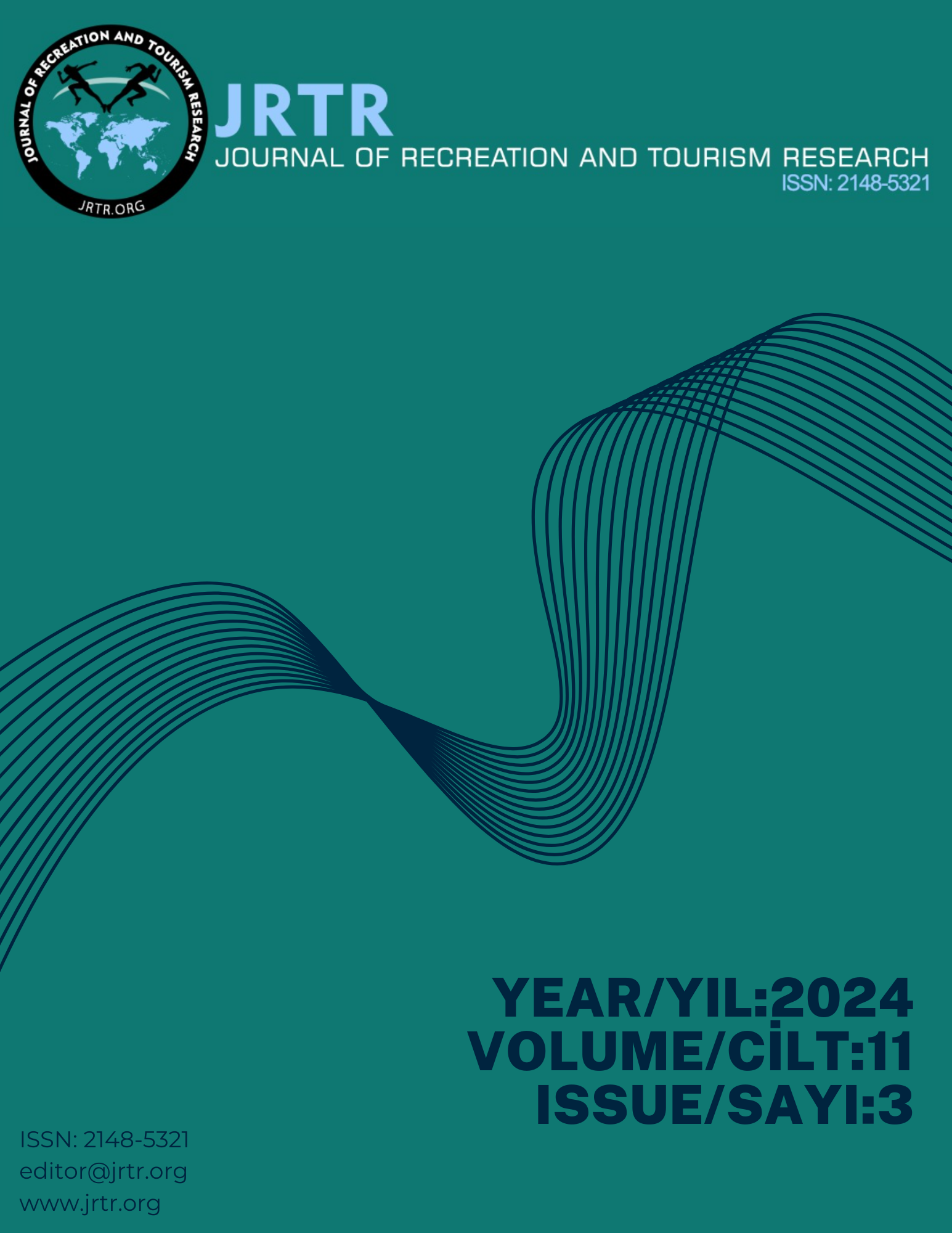Evaluation of the North African Countries in Terms of Gastronomy
DOI:
https://doi.org/10.5281/zenodo.13853849Keywords:
Culinary Culture, Cuisine of North African Countries, Table MannersAbstract
African countries possess unique culinary cultures characterized by their distinct nature and climate. The African cuisine, which has interacted with various cultures over centuries, harbors a cuisine worthy of exploration with its distinctive foods. In this context, the aim of the research is to acquire information about the history, culinary culture, table manners and serving styles, special cooking techniques, food and beverage rituals, and prominent dishes of the North African region countries. The necessity of the study arises from the absence of previous research on the subject. Additionally, the study is highly important for identifying similarities between North African culinary culture and other regional cuisines and contributing to the literature. It is observed that the culinary culture of North African countries is more closely related to Asian cuisine. In North African cuisine, tables are adorned with a variety of fruits, vegetables, grain products, small livestock meats, spices, soups, stews, salads, and pastries. Regions with access to the Nile River, such as Egypt, tend to consume more fish. The use of spices is widespread in national cuisines. In the Moroccan cuisine, influenced by Arab cuisine, salt and sugar are often used together. Due to the dominance of Arab culture in the region, the influences of the Islamic religion have shaped dietary habits, replacing alcoholic beverages with tea, mint tea, and fruit syrups.
Downloads
References
Aydın, M. Z. (1997). Sosyo-kültürel Açıdan Bugünkü Tunus, Cumhuriyet Üniversitesi ilahiyat Fakültesi Dergisi, Tunus Ülke Raporu, İstanbul, İTO yayınları.
Ayyıldız, S ve Durlu-Özkaya, F. (2019). Doğu Afrika Ülkeleri Mutfak Kültürü, Akademik Sosyal Araştırmalar Dergisi,7(96), 299-316.
Cusack, I. (2000). African Cousines: Recipes for Nation Building, Journal of African Cultural Studies, 13(2), 207-225.
Dağ, A., E. (2015). Afrika’da Müslüman Azınlıklar, İHH İnsani Yardım Vakfı, Pelikan Basım, 11-189.
Diane, L.(2007). İntegrating African Cousines and İdentity in Tigray, Highland, Ethiophia, Journal of Social Archaeology, 7 (3), 357.
El-Khouly, M., M. (2018). Egypt, Springer International Publishing AG, Cairo, Egypt, 7-26.
Embassy of Algeria (2016). Algeria’s History, https://www.algerianembassy.co.in/news/algeriahistory adresinden 25.08.2024 tarihinde alınmıştır.
Erdoğan, P. (2008). Akdeniz Mutfakları, İtalya, Fransa, İspanya, Kuzey Afrika, Ortadoğu, Türkiye, Yunanistan, Balkanlar, İstanbul; Alfa Yayınları.
Genç, H. Oktar, T ve Varlı, A.(2010). Ortadoğu ve Kuzey Afrika Ülkelerinde Ekonomik Dönüşüm, İstanbul Ticaret Odası Ekonomik ve Sosyal Araştırmalar Merkezi, İstanbul.
Giovanucci, P. (2008). Literature and Development İn North Africa, New York, Taylor And Francis Publishing Group.
Helstosky, C. (2009). Food Culture in the Mediterranean, Food Culture Around The World, Bloomsbury Publishing, London.
Holland, M. (2016). Yemek Atlası, Otuz Sekiz Mutfakta Dünya Turu, ( Çeviren Saliha Nilüfer) Yapı Kredi Yayınları, İstanbul, 313- 324.
Jacob, J and Michael, A. (2007). The World Cookbook For Students,Afganishtan to Cook Islands, London, Greenwood Press, 1(5), 12-13.
Kılınç, O. ve Kılınç, U. (2015). “Afrika Mutfağı”, Uluslararası Gastronomi, Temel Özellikler- Örnek Menüler ve Reçeteler, Detay Yayıncılık, Ankara, 276-303.
Mallos, T, ve Malcolm, L. (2013). The Little Moroccan Cookbook More Than 80 Delicious Recipes, Australia, Murdoch Books, 20-23.
Nenes, M.F. (2009). International Cuisine, John Wiley and Sons Inc, Canada, 506.
Oruç, Ş. (2008). İstanbul Ticaret Odası Ekonomik ve Sosyal Araştırmalar Şubesi Sudan Ülke Raporu.
Prepared Foods. (2009). A Taste of Regional African Cousine, Culinary Cretaions, https://www.preparedfoods.com/articles/107807-article-a-taste-of-regional-african-cuisine adresinden 25.08.2024 tarihinde alınmıştır.
Park, S., J., Y. (2011). Algeria (içinde Ken Albala) Food Cultures of the World Encyclopedia, https://books.google.com.tr/books? adresinden 25. 08.2024 tarihinde alınmıştır.
Sak, R., Şahin Sak, İ. T., Öneren Şendil, Ç., ve Nas, E. (2021). Bir Araştırma Yöntemi Olarak Doküman Analizi. Kocaeli Üniversitesi Eğitim Dergisi, 4(1), 227-250. http://doi.org/10.33400/kuje.843306.
Sussman, S. (2017). https://encyclopedia.ushmm.org/content/tr/article/jewish-population-of-french-north-africa adresinden 18. 10. 2017 tarihinde alınmıştır.
Tepeciklioğlu, E., E. (2012). Afrika Kıtasının Dünya Politikasında Artan Önemi ve Türkiye-Afrika İlişkileri, Yaşar Üniversitesi Uluslararası İlişkiler Bölümü, Ankara Üniversitesi Afrika Çalışmaları Dergisi, 1(2), 60-61.
Tontuş, H., Ö. (2014). Kuzey Afrika Libya, http://www.saturk.gov.tr/images/pdf/ust/libya.pdf adresinden 08. 10. 2017 tarihinde alınmıştır.
Türker, N ve Ayyıldız S.(2020). Dünya Mutfak Kültürleri, Cezayir Mutfağı, Beta Yayınları, İstanbul, 55-56.
U.S. Department of State. (2022). Report on International Religious Freedom: Tunisia. www.state.gov/reports/2022-report-on-international-religious-freedom/tunisia adresinden 10.08.2024 tarihinde alınmıştır.
Wignet, M ve Chalbi, H. (2004). Cooking the North Afrıcan way Lerner Publications Company, America 41-42.
Wilbert, J. (2004). Journey Through North Africa, İngredient Challenges Cullinary Prepared Foods, 35-38.
Yılmaz, H. (2016). Dünya Mutfakları I. Eskişehir, Anadolu Üniversitesi Yayınları, 208-210.
Downloads
Published
How to Cite
Issue
Section
License
Copyright (c) 2024 Journal of Recreation and Tourism Research

This work is licensed under a Creative Commons Attribution-NonCommercial 4.0 International License.






